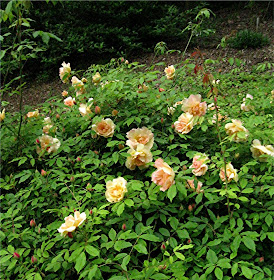




 from the top: a view inside out with the big River Birch arching over everything, Salvia x 'Eveline', Hydrangea quercifolia 'Little Honey', Sambucus nigra 'Black Lace' Lonicera sempervirens, Goldie's Fern with Phlox stolonifera and Coralbark Maple
from the top: a view inside out with the big River Birch arching over everything, Salvia x 'Eveline', Hydrangea quercifolia 'Little Honey', Sambucus nigra 'Black Lace' Lonicera sempervirens, Goldie's Fern with Phlox stolonifera and Coralbark MapleI'm going to have to weed this weekend: all that rain! Still, there are a lot of different plants in bloom, the banana is up, so are the gingers, and most happily for me, the Ninebark 'Diablo' that I moved to a corner adjacent to "Buzz Lightyear" (the
Betula nigra) seems to be able to handle the root competition. It would be great to have an alternative to the nandinas there and this seems to be working. I first saw this Salvia at
North Creek Nurseries; a
Future Plants release, it's quite dependable and obviously beautiful. 'Little Honey' Oakleaf hydrangea I tried as an experiment. There was a good deal of negative buzz about it, but it seems to be doing well though it's only been in the ground a year. It sits in a grouping incuding 'Diablo' Ninebark, Cotinus 'Royal Purple', and last year Canna 'Australia'; all those plants have super dark foliage and the yellow hydrangea looked like it was on fire amongst all that maroon and purple. The dark foliage of the elderberry does look good against the pale wall; it's got a few buds so it'll flower soon and it's growing strongly. The flowers will be pink. The older I get, the less I resist pink flowers. The last two pictures include some natives,
Lonicera sempervirens, Trumpet Honeysuckle, is a wonderful native vine that flowers heavily now, but is hardly ever without flowers. It isn't fragrant, but it won't eat the whole garden either. In the bottom picture, the tree is a Coral Bark Japanese Maple, but the flowers are
Phlox stolonifera and the fern is one of my favorite native plants,
Dryopteris goldiana, Goldie's Fern. I just stuck a small division of one of my plants in last year and it's taken hold.
The garden is really coming in and I'm pretty psyched!






































